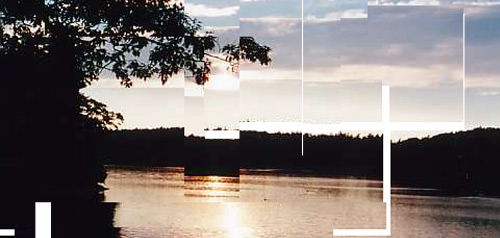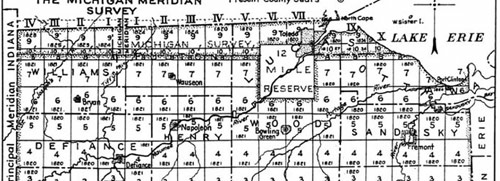|
Undesigning
America
by Amos Klausner
Retreating to the woods
surrounding Walden Pond, Henry Thoreau
sought to make for himself a life that
was deliberate and by his own hand. Cloistered
along those reflective shores, Thoreau
defined a two year journey of escapism.
His was a premeditated retreat from a young
nation still bursting with the newly initiated
who were filled with the excitement and
energy to define their place in America.
Writing, in 1846, about his time in the
woods Thoreau noted, "There is an incessant
flow of novelty into the world, and yet we
tolerate incredible dullness." The author
fills his memoir with detailed musings on
the pleasures of sounds and seasons at Walden.
In the wild he is unplugged and re-energized.

While it may seem premature to tune in, turn
on and drop out as far back as the mid 1800's,
Thoreau was living in a time marked by rapid
expansion into new corners of the American
landscape. (Only three years later gold fever
would spread from coast to coast, turning
small mission towns like San Francisco into
dense urban centers.) With expansion came
opportunities to define and divide new territory.
The Land Ordinance of 1785, drafted by Thomas
Jefferson, extended government authority
over the Mississippi River and the Great
Lakes regions. As a response to what he believed
to be a confusing survey system already in
use, Jefferson suggested a new grid system
based on the rectangle. The grid divided
land into plots one mile square, each consisting
of 640 acres. The grid also placed a visible
design upon a relatively untouched landscape.
The ordinance was the first of its kind in
America but would continue to affect urban,
suburban and farmland planning to present
day.

Jefferson's grid and Thoreau's reaction
to it represent the constant tension between
the spaces we define and the choices we
make in how we inhabit them. This friction
expresses itself not only through land
planning but also through the disciplines
of architecture, industrial design and
information design. In the current global
economy our experiences are increasingly
predetermined. Armed with human logic algorithms
and programmed responses, ours are interactions
more frequently based on computer models,
cost benefit analyses and best-case scenarios.
In opposition to this is Undesign. Characterized
as places, spaces and encounters that can't
be pre-qualified, undesigned spaces succeed
because they are unique, because they change
over time and because they are entropic,
random and natural.
In architecture and land planning the organic
rise of place and its inherently disparate
building programs is described as slow
space. Michael Bell, a professor of architecture
at Rice University and leading proponent
of slow space theory, notes that these
are zones within the urban envelope that
are created by "default rather than
intention". Using Houston as a case
study, Bell investigates how political,
social and economic conditions can align
to allow for development that was born
outside the grid. In slow space architecture,
empty spaces and commerce collide in an
environmental free for all. Small and medium
sized cities across America often call
these areas "the strip". The
word alone evokes images of polished car
dealerships, family restaurants with oversized
neon signs, full serve gas stations and
mid century shopping palaces. But that
is our parent's strip, a place where diverse
interests could comfortably convene to
serve the needs of many. Houston not withstanding,
the strip as we learned it is slowly disappearing
in favor of a version modified and re-designed
by a new set of political, social and economic
forces. Today the strip defines our worst
fears about land shaping and slow space
is giving way to something more akin to
faux space. Along once scenic routes, the
stimulating unpredictability of undesign
is giving way to a new paradigm where the
strip connects a profusion of tilt-up subdivisions
with look-alike houses. Whether it is two,
four, six or even eight lanes wide, the
strip can continue indefinitely, repeating
itself every twenty miles with a population
of big box retailers clustered together
in the new American mall. And with each
off ramp to Target and Wal-Mart the traffic
slows to a crawl. The once sublime acts
of travel, business and communication have
been debased as the Jeffersonian grid continues
to expand beyond its initial survey.
Undesign is more than nostalgia. It is
wild space. At the urban core there are
still pockets of wild-ness. The inner city
or the ghetto and its deep urban landscape
succeed in contrast to modern development
because it is relatively untouched by planners,
designers and architects (perhaps because
the numbers aren't there). Left with a
combination of local redevelopment initiatives,
run down housing and ruins, these spaces
become increasingly valuable because they
are truly reflective of the people who
live and work there. Photographer and ethnographer
Camilo Vergara has dedicated his career
to investigating the decay and reuse of
inner city buildings and in turn the communities
affecting those changes. From the Bronx
to Chicago and from Detroit to Los Angeles,
Vergara (2002 recipient of a MacArthur
Fellowship) has chronicled subtle changes
in forgotten and overlooked places. His
work is both a growing archive on the transformation
and history of American inner cities and
a reminder that a vibrant, if underprivileged,
society exists just under the surface.
Responding to a question about why he has
dedicated his attention to urban poverty
Vergara responded, "I've always been
interested in places that enhance my sense
of instability and the precariousness of
my own existence." His current project
documents the reuse of ghetto architecture
as storefront churches. The churches, proclaimed
sacred spaces by ambitious pastors and
re-branded with homespun additions and
hand painted signs, often disappear as
quickly as they arrived.

Moving away from the grit and uncertainty
of the ghetto, past color-coded suburban
subdivisions, undesign thrives along the
knife-edge where habitation meets emptiness.
An important transition zone between the
built and unbuilt environment appears along
tired gas and lodging strips where weathered
billboards advertise Christian salvation
along with beef jerky by the pound. This
is where we can find the last vestige of
the wistful kicks found along routes made
famous in American automotive culture.
It also exists as space in flux. The instability
between what is and what might be is powerful
and the threat that dirt pull-outs, suicide
lanes and hushed diners may give way to
the ever extending ribbon of suburban sprawl
is real. At times the two clash in an explosion
that has been captured by the lens of graphic
designer and photographer Rudy VanderLans
(of type foundry Émigré fame).
VanderLans has plied the backroads of the
Southern California desert to uncover an
exciting dichotomy. His recently published
book, Supermarket, is filled with plush
images that vividly witness this friction.
Similar in essence to Camilo Vergara's
photographs, Rudy VanderLans captures a
threatened landscape and the demise of
undesign in favor of a more routine and
dependable alternative.

Just on the other side of the road, desert
sand gives way to an American wilderness
that asks us to stand alone against nature.
The obvious lack of protection and creature
comforts might suggest that human interactions
with natural wilderness would be limited.
Just the opposite is true. Our national
parks and wilderness areas are more heavily
traveled than ever, prompting restrictions
on access to popular destinations like
Yosemite Valley. In the past twenty years
total visits to U.S. national parks has
risen from almost 283 million total visits
in 1979 to a peak of 436 million total
visits in 1999, an increase of 54 percent.
The large-scale interest to immerse oneself
in a completely undesigned environment
is astounding. It is also a call to arms
for multiple generations whose history
and memory of place is being drowned
by solutions that are driven by an information
age scaled more to immediacy, economics
and productivity than personality.
Thoreau's Walden was never pure wilderness
and today it is an ordinary New England
swimming hole. Still, the lessons learned
at Walden and Thoreau's detailed account
of his time spent there make it a mythical
place. If Jefferson's grid continues
to broaden its reach, rising off the
land
into a third dimension and marking our
lives in new ways, then disorder as a
response to artificiality may be the
novelty we
have forgotten.
Amos Klausner is the
Director of the San Francisco chapter
of the American Institute of Graphic
Arts.
|






